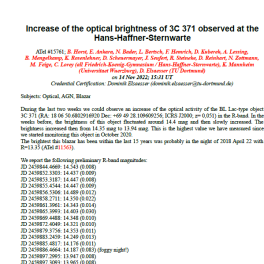
Polarlichter über der Hans-Haffner-Sternwarte
In der Nacht von Freitag, 10. Mai 2024 auf Samstag, 11. Mai 2024 waren an der Hans-Haffner-Sternwarte spektakuläre Polarlichter zu beobachten.

Erneut ein Astronomer's Telegram veröffentlicht
"ATel #16403: Rapid increase in the optical brightness of the blazar AO 0235+164" Dieses Astronomer's Telegram ist nun schon das 22. ATel das das Schüler-Team der Hans-Haffner-Sternwarte veröffentlichen konnte.

Bauantrag für die Erweiterung der Sternwarte ist genehmigt
Die Hans-Haffner-Sternwarte soll im nächsten Jahr um einen kleinen Kuppelbau und ein größeres Gelände von gut 300 Quadratmetern erweitert werden. Das Landratsamt Würzburg hat nun den Bauantrag für das Kuppelgebäude genehmigt, so dass die Arbeiten im Frühjahr 2024 aufgenommen werden können.

Naturwissenschaftliche Bibliothek rundum erneuert
Nach über 2 Jahren ist der Erneuerung der Naturwissenschaftlichen Bibliothek nun beendet. Zunächst wurde der eigentlich Raum der Bibliothek, der Raum H17a komplett erneuert.

13. Astronomers Telegram: starke Helligkeitszunahme des AGN 3C 371
Seit Anfang November stieg die Helligkeit des AGN 3C 371 kontinuierlich leicht an. Am Sonntagabend, 12.11.2022 konnten wir eine stärkere Zunahme der optischen Helligkeit dieses Objekts messen.

Auszeichnung für Astronomie-Projekt des FKG-Schülerlabors
Die Astronomie-Gruppe des Naturwissenschaftlichen Labors am FKG des Friedrich-Koenig-Gymnasium wurde am Wochenende in Bochum mit einem Reiff-Preis für Schul- und Amateurastronomie ausgezeichnet.

Daten aus Hettstadt halfen, dem Rätsel von Knick-Instabilitäten in Jets näher zu kommen
In den natürlich vorkommenden Plasmatrömen der Jets von aktiven Galaxienkernen werden magnetohydrodynamische Instabilitäten vermutet, allerdings konnten die genauen Zusammenhänge mit plötzlich auftretenden Helligkeitsausbrüchen der AGN, sogenannten Flares, bisher nicht vollständig enträtselt werden. In der aktuellen Ausgabe der hochrenomierten Fachzeitschrift Nature ist nun ein Artikel erschienen, in dem ein wichtiger Schritt in diese Richtung unternommen wird.

Der AGN S4 0954 erreichte ein absolutes Helligkeitsmaximum
In der Nacht vom 11. auf den 12. Mai konnten wir eine starke Zunahme der optischen Helligkeit des AGN S4 0954 messen. Diesen AGN haben wir erst seit knapp zwei Jahren in unserem Messprogramm. Kurz nach der Detektion kam von Tom Balonek von der Colgate Universität in New York über den E-Mail-Verteiler der Whole Earth Blazar Telescope (WEBT) Collaboration ein Hinweis auf diese Helligkeitszunahme. Auch italienische Wissenschaftler konnten diesen Helligkeitsausbruch messen. In den folgenden Nächten wurde S4 0954 von den Wissenschaftlern aus New York, Siena und Mailand sowie von uns noch engmaschig überwacht. Am 14. Mai konnte dann in einer gemeinsamen Aktion ein Astronomers Telegram zu diesem Ereignis als Gemeinschaftsleistung veröffentlicht werden. S4 0954 gehört zur Untergruppe der BL-Lacertae-Objekten, eine Gruppe von aktiven Galaxienkernen, die sehr lichtstark sind. Wissenschaftler gehen davon aus, dass bei diesen Objekten die Akkretionsscheibe mehr oder weniger senkrecht zu unserer Blickrichtung steht, so dass wir nahezu direkt in den Jet schauen. Dies erklärt auch die relativ große Helligkeit dieser Himmelsobjekte.

Zwei neue Pilzkulturen im Schülerlabor etabliert
Im Schülerlabor konnten zwei weitere Sterilkulturen von Pilzen etabliert werden. Zum einen Kulturen vom Mutterkornpilz Claviceps purpurea und zum anderen von Trichoderma reesei. Der Mutterkornpilz, der zur Gruppe der Schlauchpilze gehört, parasitiert auf Getreideähren, vor allem auf denen von Roggen. Das bläulich-schwarze bis zu vier Zentimeter lange Mutterkorn ist ein Dauerstadium (Sklerotium), mit dem der Pilz den Winter übersteht. Dieses enthält ein Gemisch von einigen Dutzend zum Teil hoch toxischen Alkaloiden. Im Mittelalter und der frühen Neuzeit hat der Verzehr von mit Mutterkorn befallenem Getreide das sogenannte Antonius-Feuer verursacht. Ein an der heute Ergotismus genannten Krankheit Leidender wurde von Matthias Grünewald auf der zweiten Rückseite des Isenheimer Altars dargestellt. Später wurden Mutterkornextrakte auf Grund ihrer gefäßverschließenden Wirkung zum Blutstillen nach einer schweren Geburt eingesetzt. Die nun etablierten Linien sollen zum einen auf ihre Alkaloidzusammensetzung, als auch hinsichtlich der enthaltenden Farbstoffe analysiert werden. Sie wurden uns von der Arbeitsgruppe von Prof. Dr. Humpf von der Universität Münster zur Verfügung gestellt. Trichoderma reesei gehört ebenfalls zu den Schlauchpilzen. Er zeichnet sich durch eine hohe Produktion von Cellulasen aus, also Enzymen, die Cellulose, die Gerüstsubstanz von pflanzlichen Zellwänden, abbauen. Hier ist das Ziel, diese Cellulasen zu isolieren und diese dann für weitere Experimente einzusetzen. Die Kultur von Trichoderma wurde uns von der Arbeitsgruppe von Frau Prof. Dr. Agler-Rosenbaum vom Leibniz-Institut für Naturstoff-Forschung und Infektionsbiologie in Jena zur Verfügung gestellt.

Helligkeitsausbruch beim AGN 3C 345 entdeckt
Anfang April zeigte der AGN 3C 345 erhöhte Aktivität im Gamma-Bereich des elektromagnetischen Spektrums. Dies wurde sowohl vom Fermi LAT, dem Large Area Telescope auf dem Fermi-Satelliten als auch vom AGILE-Satelliten detektiert. Der Forschungssatellit Swift konnte in den folgenden Tagen dann zusätzlich eine Zunahme der Röntgenstrahlung von diesem Objekt messen. Den AGN 3C 345, es handelt sich um einen Quasar, haben wir schon seit einigen Jahren in unserem Messprogramm an der Hans-Haffner-Sternwarte. So waren wir in den nächsten Nächten besonders aufmerksam und konnten dann tatsächlich im Zeitraum vom 17. bis zum 20. April eine Zunahme der Helligkeit dieses AGN um über eine Magnitude im R-Band weltweit als Erste messen und unser nun zehntes Astronomers Telegram veröffentlichen.

Komet C/2020 F3 (Neowise) über der Hans-Haffner-Sternwarte
Für einen Kometen dieser Größe – der Durchmesser wird von der NASA auf ca. 5000 Meter geschätzt – ungewöhnlich spät wurde dieses Himmelsobjekt erst im Frühjahr dieses Jahres entdeckt. Am 27. März 2020 detektierte der Wide-Field Infrared Survey Explorer der NASA (WISE) den Kometen im Rahmen des NEOWISE-Projekts, das den Südhimmel durchmustert. Schon am 3. Juli erreichte der Komet C/2020 F3, wie er seitdem korrekt heißt, sein Perihel, also den sonnennächsten Punkt auf seiner elliptischen Bahn. Kometen bestehen hauptsächlich aus Eis und Staub – sie werden deshalb von Astronomen auch als dirty snowballs (schmutzige Schneebälle) bezeichnet – wobei es sich um Eis aus Wasser, Kohlenstoffmonoxid und Kohlenstoffdioxid handelt. Nähert sich ein solcher Eisball der Sonne, so beginnt der leicht flüchtige Teil der Materie zu verdampfen und bildet die Koma (Hülle) um den Kern des Kometen. Durch den Sonnenwind wird ein Teil der Koma weggedrückt, was dann als Schweif zu sehen ist. Ab Anfang Juli war NEOWISE, so sein umgangssprachlicher Name, sehr gut am Morgenhimmel über der Hans-Haffner-Sternwarte zu beobachten. Da er sich nun wieder von der Sonne entfernte, wurde er mit jedem Tag dunkler. Gleichzeitig verschob sich die Sichtbarkeit im Tagesverlauf weiter nach vorne, so dass er ab Mitte Juli auch am Abendhimmel zu sehen war. Am 23. Juli hatte er mit 103,5 Mio. km den geringsten Abstand zur Erde erreicht. In den darauffolgenden Nächten wurde die Helligkeit dieses Schweifsterns immer geringer und seit Anfang August ist er mit bloßem Auge nicht mehr zu erkennen. Wenn er seine Reise durch das All unbeschadet übersteht, wird C/2020 F3 erst wieder in 6700 Jahren an der Erde vorbeiziehen.

Neues Zellaufschlussverfahren etabliert
Bakterien können gentechnisch so verändert werden, dass sie bestimmte Proteine herstellen. In der Pharmazeutischen Industrie wird so zum Beispiel humanes Insulin gewonnen. Im Schülerlabor werden durch transgene Escherichia coli-Bakterien fluoreszierende Proteine synthetisiert. Ursprünglich stammt das Gen für das grün fluoreszierende Protein (GFP, green fluorescent protein) aus der Qualle Aequorea victoria. Dieses Protein kann mit ultraviolettem Licht zur grüner Fluoreszenz angeregt werden. Das GFP wurde 1962 vom japanischen Biochemiker Osamu Shimomura erstmals beschreiben. In der modernen Forschung ist das GFP und die von ihm ausgehenden Varianten ein wichtiges Werkzeug zur Untersuchung der räumlichen und zeitlichen Verteilung von Proteinen in einer Zelle. Dazu wird das GFP-Gen mit dem zu untersuchenden Protein-Gen gekoppelt. Wird nun dieses Gen exprimiert, wird auch das GFP mit synthetisiert. Durch Bestrahlung mit UV-Licht fängt nun das GFP an zu leuchten und so können dann Ort und Zeit des Auftretens des zu untersuchenden Proteins bestimmt werden. In der Zwischenzeit gibt es zahlreiche, in allen Farben fluoreszierende Proteine. Im Schülerlabor stellen wir Bakterien her, die entweder ein grün (GFP) oder ein rot (RFP) fluoreszierendes Protein herstellen. Nachdem die transgenen Bakterien über Nacht inkubiert wurden, haben sie das Protein hergestellt. Dieses wird anschließend aus den Bakterien extrahiert, wozu die Bakterien „geknackt“ werden. In Ermangelung anderer Alternativen geschah der Zellaufschluss im Schülerlabor bisher mittels enzymatischen Verdaus mit Lysozym. Dieses Verfahren war sehr langwierig und nicht sehr erfolgreich. Nun konnte ein Ultraschall-Desintegrator für den mechanischen Zellaufschluss mit Ultraschall angeschafft und das neue Verfahren im Schülerlabor implementiert werden. Der Ultraschall-Desintegrator überträgt mit einer Sonotrodenspitze energiereiche Ultraschallwellen in die Bakteriensuspension. Durch die dadurch entstehenden Kavitationskräfte (Kavitation: Entstehung und Auflösen von Gasbläschen) stoßen die Bakterienzellen heftig aneinander und zerscheren so. Dadurch wird der Zellinhalt inklusive der Proteine freigesetzt. Die Proteine können nun entsprechend aufgereinigt und rein gewonnen werden. Die Etablierung dieses Verfahrens erfolgte durch die ehemaligen FKG-Schüler Jannik Kania und Julius Klamt, die an der Universität Würzburg Chemie und Biologie studieren.

Helligkeitsmaximum des AGN OJ 287 entdeckt
Die Helligkeit des Blazar OJ 287 wird seit Beginn des Forschungsprojekts „AGN-Monitoring“ regelmäßig von uns bestimmt. Ab Ende März 2020 konnten wir eine Zunahme der Helligkeit dieses Objekts feststellen, die am 26. April 2020 ihren Höhepunkt erreichte. In diesen knapp sechs Wochen nahm die Helligkeit dieses Aktiven Galaxienkerns (AGN) um 1,25 Größenklassen zu, um danach wieder zu sinken. Diese Entdeckung wurde in einer Ad-hoc-Mitteilung im Astronomer's Telegram weltweit veröffentlicht. The Astronomer's Telegram ist eine Internetplattform, auf der bedeutende astronomische Ereignisse schnell weltweit verbreitet werden, so dass sie dokumentiert sind und rund um die Welt überprüft werden können. Die Messung und Auswertung der Schüler deckte sich mit den Beobachtungen anderer Arbeitsgruppen sehr gut. Die Überwachung der AGN an der Hans-Haffner-Sternwarte erfolgt in Abstimmung mit der MAGIC-Kollaboration, die ein Teleskopsystem für Gammastrahlung auf der Kanareninsel La Palma betreibt. Leider konnten dort auf Grund des Corona-shut-down keine Parallelmessungen durchgeführt werden. OJ 287 befindet sich im Sternbild Krebs, ist 3,5 Milliarden Lichtjahre von der Erde entfernt und enthält mit 18 Milliarden Sonnenmassen eines der größten bekannten Schwarzen Löcher. Dieses supermassenreiche Schwarze Loch wird von einem kleineren, ungefähr 100 Millionen Sonnenmassen schweren zweiten Schwarzen Loch umkreist, das für einen Umlauf ungefähr 12 Jahre benötigt. Dabei passiert es zweimal die Akkretionsscheibe des zentralen Schwarzen Lochs, was zu starken Störungen des davon ausgehenden Jets führt. Dies zeigt sich auch auch in von der Erde aus beobachtbaren Helligkeitsschwankungen. Durch die Helligkeitsausbrüche war es möglich, die Massen dieses Binärsystems Schwarzer Löcher sehr genau zu bestimmen. Auch die Umlaufbahn des kleinen Schwarzen Loch konnte sehr genau bestimmt werden. Dabei wurde auch festgestellt, dass sich beide Schwarzen Löcher annähern und in 10 000 Jahren miteinander verschmelzen. Deshalb ist OJ 287 auch ein interessantes Objekt für die Messung von Gravitationswellen mit dem geplanten Weltrauminterferometer LISA. Das Projekt „AGN-Monitoring“ in Zusammenarbeit mit dem Lehrstuhl für Astronomie der Universität Würzburg und dem Lehrstuhl für Experimentelle Teilchenphysik Vb der Technischen Universität Dortmund existiert seit dem Jahr 2012.


